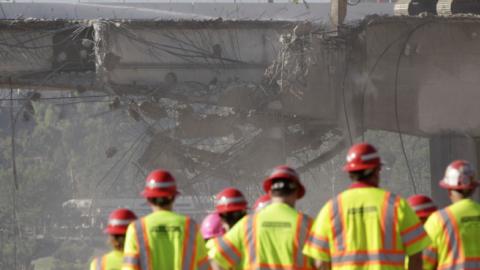When politicians and pundits say America's infrastructure is in dire shape, they're usually getting that idea at least in part from a report by the American Society of Civil Engineers. The latest ASCE study was released last week, The Washington Post reports:
The Trump administration promises to pump $1 trillion into improving the country’s crumbling infrastructure, but a benchmark report says it will take almost $4.6 trillion over the next eight years to bring all those systems up to an acceptable standard.
The price tag for redemption has grown steadily for 15 years while an expanding country has focused on building new infrastructure rather than maintaining existing systems that were nearing the end of their natural life.
Since 2001, the cost of repairing those systems has mushroomed from $1.3 trillion to the current figure, more than three times as high, according to an assessment released Thursday by the American Society of Civil Engineers (ASCE). The report comes out every four years.
It gave the U.S. infrastructure an overall grade of D-plus, the same grade it received in 2013, “suggesting only incremental progress was made over the last four years.”
“President Trump is on to something when he calls for a national rebuilding,” ASCE President Norma Jean Mattei said in presenting the study. “But Congress and the American people have to pay for it.”
ASCE's claims always have to be taken with several grains of salt; as an industry trade group, their members would benefit from trillions of the dollars in infrastructure spending. So while we support more infrastructure spending, we're skeptical of the ASCE's $4.6 trillion headline figure. It's easy to come up with $4.6 trillion in projects that seem useful. But that doesn't mean they're necessary.
Nor does this report say much about prioritization and rigorous cost-benefit analysis. Americans aren't going to spend $4.6 trillion on infrastructure, so what should be our focus and how do we make sure to get the most bang for our buck? As Alon Levy explained in these pages a couple of weeks ago, American governments spend construction money horribly inefficiently.
President Trump is said to be turning to infrastructure soon (a politically savvy move, as Jason Willick writes). Moreover, Trump seems to understand that America is getting a bad deal, and the Washington Post reports that the White House is planning a "fix it first" approach, whereby money is directed first and foremost to repairs, not to new construction. Trump is also said to be mulling a requirement that projects must be started within three months of receiving funding. It's an intriguing idea, and thanks to the dearth of "shovel-ready" projects, it would favor maintenance over new construction. That's a very good thing; spending on repairs is generally more likely to deliver benefits than new projects. Meanwhile, self-driving cars may mean we need fewer roads and bridges (and rail), as traffic patterns clear up thanks to sophisticated onboard algorithms.
Yet there's reason to be nervous that Trump, who likes big flashy things, will want too much for projects like high-speed rail, which reports say he's shown an interest in. Repairing bridges isn't as sexy as a brand new highway that promises a ribbon-cutting photo op. We hope he resists this temptation. Even privately-funded high-speed rail, like the project being proposed in Texas, will divert resources from other efforts.
If so much of America's infrastructure weren't crumbling, it might make sense to invest in bold new modes of transportation. We'd still be skeptical that non-freight rail is a big part of that future for a sprawling country like the United States. But there are plenty of maintenance projects which need funding. Trump should start with those—and he should find a way to do it with much less than $4.6 trillion.












